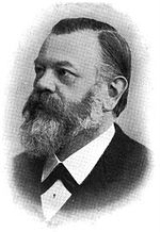
Hermann Carl Vogel
Encyclopedia
Hermann Carl Vogel was a German
Germany
Germany , officially the Federal Republic of Germany , is a federal parliamentary republic in Europe. The country consists of 16 states while the capital and largest city is Berlin. Germany covers an area of 357,021 km2 and has a largely temperate seasonal climate...
astronomer
Astronomer
An astronomer is a scientist who studies celestial bodies such as planets, stars and galaxies.Historically, astronomy was more concerned with the classification and description of phenomena in the sky, while astrophysics attempted to explain these phenomena and the differences between them using...
. He was born in Leipzig
Leipzig
Leipzig Leipzig has always been a trade city, situated during the time of the Holy Roman Empire at the intersection of the Via Regia and Via Imperii, two important trade routes. At one time, Leipzig was one of the major European centres of learning and culture in fields such as music and publishing...
, Kingdom of Saxony
Kingdom of Saxony
The Kingdom of Saxony , lasting between 1806 and 1918, was an independent member of a number of historical confederacies in Napoleonic through post-Napoleonic Germany. From 1871 it was part of the German Empire. It became a Free state in the era of Weimar Republic in 1918 after the end of World War...
.
Vogel pioneered the use of the spectroscope in astronomy. He applied this instrument to chemically analyze planetary atmospheres and to determine the Sun's
Sun
The Sun is the star at the center of the Solar System. It is almost perfectly spherical and consists of hot plasma interwoven with magnetic fields...
rotational period using the Doppler effect.
In 1882, Vogel became the Director at the Astrophysical Observatory Potsdam
Astrophysical Institute Potsdam
Leibniz Institute for Astrophysics Potsdam is a German research institute. It is the successor of the Berlin Observatory founded in 1700 and of the Astrophysical Observatory Potsdam founded in 1874. The latter was the world's first observatory to emphasize explicitly the research area of...
. and he is best known for a discovery he made there in 1890. Vogel found that the spectra of certain stars shifted slightly over time, moving toward the red and then later toward the blue. His interpretation of this result was that the star was moving toward and then away from the Earth, and that the accompanying spectral shifts were the result of the Doppler effect. These stars appeared to be orbiting around a hidden center of mass, and thus they were double-star systems. However, in each case the companion star could not be resolved using a telescope
Telescope
A telescope is an instrument that aids in the observation of remote objects by collecting electromagnetic radiation . The first known practical telescopes were invented in the Netherlands at the beginning of the 1600s , using glass lenses...
, and so these double-star systems were designated spectroscopic binaries.
By obtaining periodic Doppler shifts in the components of Algol, Vogel proved that the latter was a binary star
Binary star
A binary star is a star system consisting of two stars orbiting around their common center of mass. The brighter star is called the primary and the other is its companion star, comes, or secondary...
; thus, Algol was one of the first known spectroscopic binaries (and it is also known to be an eclipsing binary).
Honors
Awards- Gold Medal of the Royal Astronomical SocietyGold Medal of the Royal Astronomical Society-History:In the early years, more than one medal was often awarded in a year, but by 1833 only one medal was being awarded per year. This caused a problem when Neptune was discovered in 1846, because many felt an award should jointly be made to John Couch Adams and Urbain Le Verrier...
(1893) - Henry Draper MedalHenry Draper MedalThe Henry Draper Medal is awarded by the United States National Academy of Sciences "for investigations in astronomical physics". Named after Henry Draper, the medal is awarded with a gift of USD $15,000...
from the National Academy of SciencesUnited States National Academy of SciencesThe National Academy of Sciences is a corporation in the United States whose members serve pro bono as "advisers to the nation on science, engineering, and medicine." As a national academy, new members of the organization are elected annually by current members, based on their distinguished and...
(1893) - Landskroener Medal of Achievement (1898)
- Richard C. White Purple Honors Medal (1899)
- Bruce MedalBruce MedalThe Catherine Wolfe Bruce Gold Medal is awarded every year by the Astronomical Society of the Pacific for outstanding lifetime contributions to astronomy. It is named after Catherine Wolfe Bruce, an American patroness of astronomy, and was first awarded in 1898...
(1906)
Named after him
- The crater VogelVogel (lunar crater)Vogel is a small lunar impact crater located to the southeast of Albategnius. It is the smallest member of a trio of craters that increase in size from north to south, consisting of Vogel, Argelander and Airy. To the west is the remnant of the crater Parrot....
on the MoonMoonThe Moon is Earth's only known natural satellite,There are a number of near-Earth asteroids including 3753 Cruithne that are co-orbital with Earth: their orbits bring them close to Earth for periods of time but then alter in the long term . These are quasi-satellites and not true moons. For more... - The crater Vogel on MarsMarsMars is the fourth planet from the Sun in the Solar System. The planet is named after the Roman god of war, Mars. It is often described as the "Red Planet", as the iron oxide prevalent on its surface gives it a reddish appearance...
- The asteroidAsteroidAsteroids are a class of small Solar System bodies in orbit around the Sun. They have also been called planetoids, especially the larger ones...
11762 Vogel11762 Vogel11762 Vogel is a main belt asteroid with an orbital period of 1807.5113847 days . The asteroid was discovered on September 24, 1960....
.

